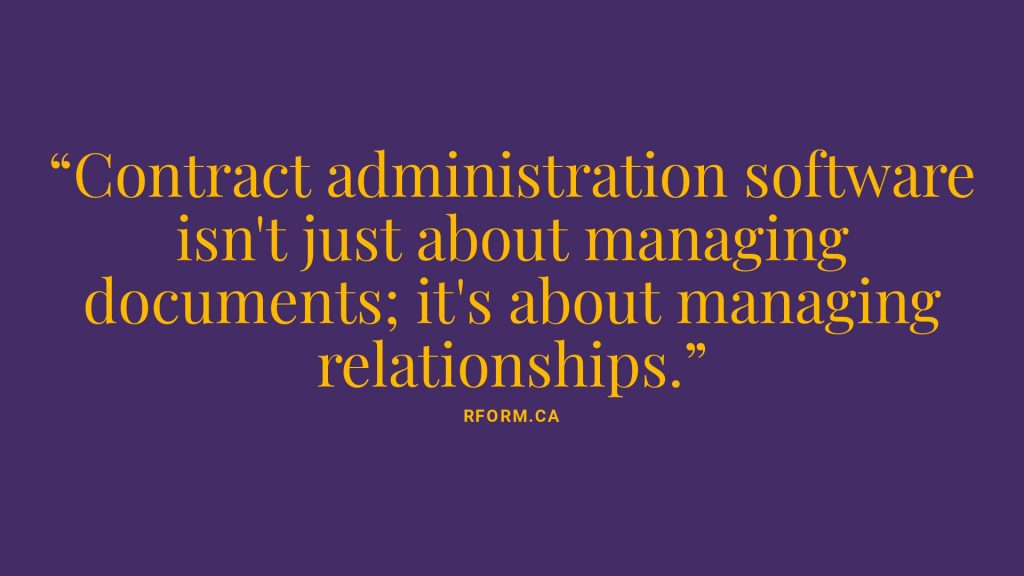In the dynamic construction landscape, where timelines are tight, budgets are scrutinized, and multiple stakeholders converge, contract administration (CA) emerges as a linchpin for project success. Often overshadowed by the more prominent project management discipline, CA, empowered by specialized software, has the potential to transform how contractors engage with their project partners.

The Limitations of Project Management Add-ons
While project management add-ons can offer basic contract management features, they often fall short in several key areas:
- Limited Functionality: Add-ons typically lack the specialized features needed for comprehensive contract administration, such as clause libraries, automated alerts, and risk assessment tools.
- Cluttered Interface: Managing contracts within a project management tool can lead to a cluttered interface, making it difficult to find relevant information or track contract-specific activities.
- Inefficient Workflows: Project management add-ons often lack the streamlined workflows for efficient contract management, resulting in fragmented processes and potential delays.
- Insufficient Collaboration: Collaboration features in project management tools may not be tailored for contract-specific discussions, leading to miscommunication and missed opportunities.
- Inadequate Reporting: Add-ons may not provide the in-depth reporting and analytics needed to monitor contract performance and identify risks effectively.
The CA Software Advantage: More Than Just Document Management
Traditionally, contract administration was synonymous with meticulous record-keeping. However, CA software has evolved into a dynamic platform transcending document storage. RForm.ca articulates that it’s about fostering “a centralized platform where all stakeholders can access, review, and collaborate on contract documents in real time.” This translates to:
- Streamlined Communication: Seamlessly share RFIs (Requests for Information), submittals, change orders, and other critical communication within a unified interface, eliminating the chaos of scattered emails and disparate systems.
- Real-time Collaboration: Stakeholders can collaboratively review documents, add annotations, and provide feedback directly within the software, promoting transparency and accelerating decision-making.
- Risk Mitigation: By maintaining a comprehensive audit trail of all communications and changes, the software minimizes the likelihood of disputes arising from miscommunication or misinterpretation of contract terms.
- Data-Driven Insights: Modern CA software often includes reporting and analytics capabilities, enabling contractors to identify trends, anticipate potential bottlenecks, and proactively manage project risks.
Beyond Efficiency: Strengthening Stakeholder Relationships
The benefits of CA software extend beyond operational efficiency. It cultivates an environment of trust and collaboration among stakeholders. When everyone can access the same up-to-date information and actively participate in the contract administration process, it fosters a sense of shared responsibility and ownership over the project’s success.
Selecting the Right CA Software: Factors to Consider
While project management add-ons may be suitable for simple projects with minimal contractual complexity, dedicated contract administration software offers a more robust and efficient solution for organizations with complex contracts or high volumes of agreements.
By investing in purpose-built CA software, organizations can streamline contract management, enhance collaboration, mitigate risks, and improve project outcomes. This ultimately leads to increased efficiency, cost savings, and stronger stakeholder relationships.
Choosing the appropriate CA software requires careful consideration of various factors:
- Ease of Use: An intuitive interface and user-friendly features are essential for widespread adoption among project teams.
- Scalability: The software should accommodate projects of varying sizes and complexities, allowing for seamless expansion.
- Integration Capabilities: Integration with other project management tools, such as scheduling and accounting software, can create a unified project ecosystem.
- Mobile Accessibility: Accessing contract information on mobile devices enhances communication and collaboration.
Implementing CA Software: A Strategic Approach
Successful implementation of CA software involves more than just purchasing a license. It requires a strategic approach:
- Clear Communication Protocols: Define guidelines for how stakeholders interact within the software, including expectations for response times and escalation procedures.
- Comprehensive Training: Ensure all project team members, from field personnel to executives, are trained to use the software effectively.
- Data Migration: If transitioning from existing systems, ensure a smooth and accurate transfer of contract data to the new software.
- Ongoing Support: Choose a vendor that provides reliable technical support and resources to address any issues that may arise.
Conclusion: A Paradigm Shift in Construction Collaboration
Contract administration software is no longer a luxury; it’s necessary for contractors who want to stay competitive in the modern construction landscape. By streamlining communication, fostering collaboration, and mitigating risks, CA software empowers contractors to deliver projects on time, within budget, and to the satisfaction of all stakeholders. As RForm.ca aptly puts it, “Contract administration software isn’t just about managing documents; it’s about managing relationships.”

